Comprehensive Analysis of Dunlop Footwear Market and Strategies Report
VerifiedAdded on 2023/01/17
|12
|3410
|90
Report
AI Summary
This report provides a comprehensive analysis of the Dunlop footwear market, encompassing a detailed examination of its vision, mission, and corporate objectives. It includes a situational analysis, covering macroeconomic factors like political, economic, social, technological, environmental, and legal environments. The report utilizes Porter's Five Forces model to assess the industry and sector dynamics, evaluating buyer power, supplier power, rivalry, threat of substitutes, and barriers to entry. Furthermore, it explores Dunlop's generic strategies, including cost leadership, differentiation, and focus strategies. The report analyzes the results obtained from a simulation game, examining the performance of different brands over several years, assessing production costs, sales channels, and market share. The analysis reveals insights into the company's strategic approach, including its focus on cost control, product differentiation, and market responsiveness. The report concludes with a discussion of potential future strategies for Dunlop to maintain its competitive edge in the global footwear market.

Financial Reporting
Paraphrase This Document
Need a fresh take? Get an instant paraphrase of this document with our AI Paraphraser
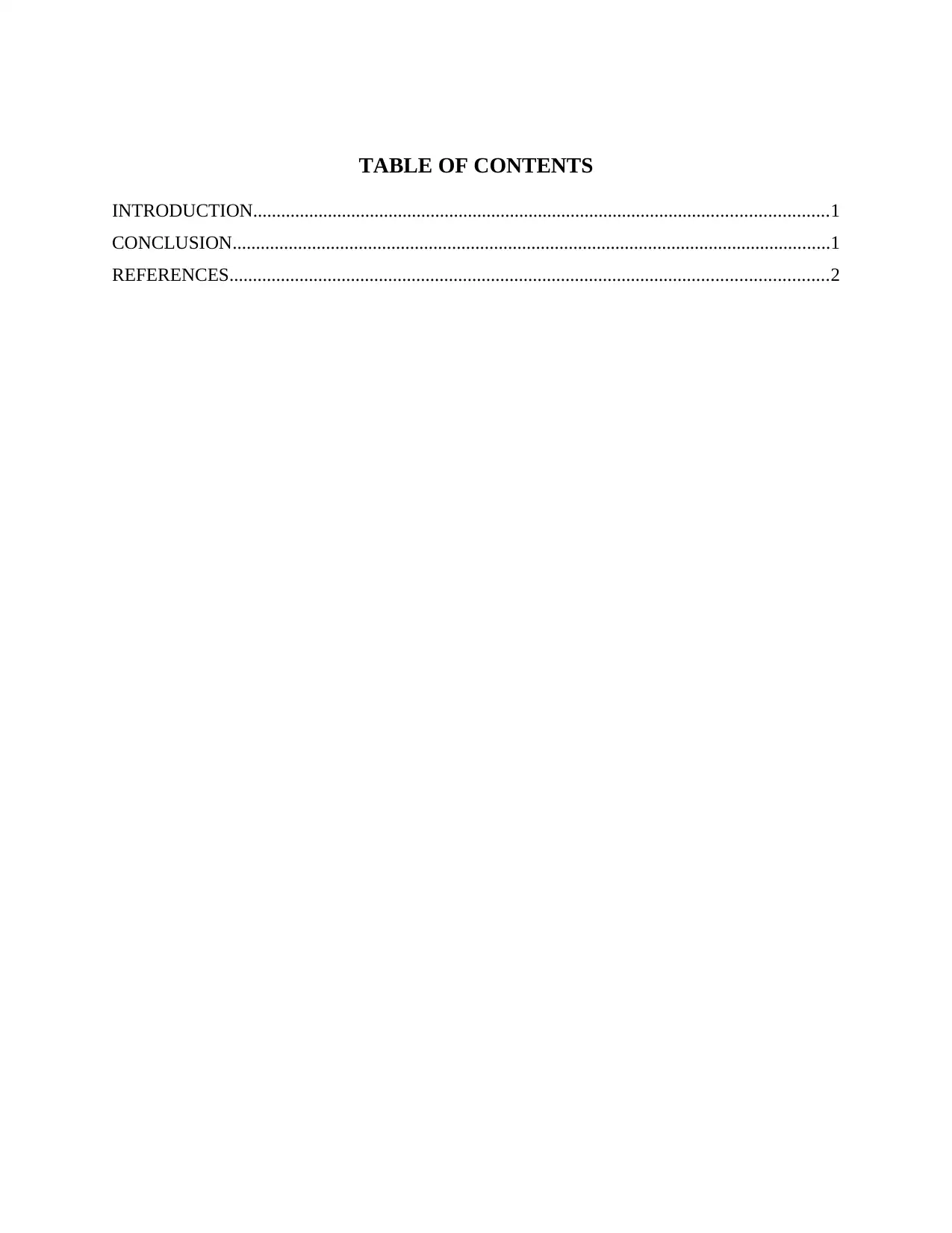
TABLE OF CONTENTS
INTRODUCTION...........................................................................................................................1
CONCLUSION................................................................................................................................1
REFERENCES................................................................................................................................2
INTRODUCTION...........................................................................................................................1
CONCLUSION................................................................................................................................1
REFERENCES................................................................................................................................2

INTRODUCTION
Global athletics foot ware market is increasing at rapid rate as now more and more people are
taking interest in sports shoes. Firms are due to this reason offer wide variety of shoes in terms of
designs to the customers. This make competition fierce. In the present report in respect to it
SWOT and PESTEL analysis is done and results obtained from simulation game are analysed in
detail. Apart from this, porter five forces model and generic strategy is done. At end of the
report, future strategy is also prepared.
2. Vision and mission statement and corporate objective
Vision: Dunlop main vision is to grow its business by doing innovation in its product
line. Firm intend to maintain its position as leading manufacturer and distribution of
shoes. They want to maintain commitment to country, culture and environment in which
it operates.
Mission: Main mission of the Dunlop is to become competitive and flexible as well as
market responsive organization in the footwear market.
Corporate objective: Main objective of the Dunlop to achieve its aim is to produce
goods at cheaper rate so that items can be provided to the people at more affordable rate
and same amount of margin can be earned.
It can be said that main aim of the firm is to maintain its strong position in the market.
Management of the company understand the significance of the cost control in the business.
In this regard firm need to cut its business expenses or need to generated economies of scale
in its business. This is the one of the most important step that will assist firm to beat its
competitors in the market.
3. Situational analysis
3.1 Macroeconomic analysis Political environment: Dunlop is operating in the footwear market and its sales are
consistently increasing across the channels and product lines. This happened because
ruling Government is preparing business friendly policy and due to this reason demand of
1
Global athletics foot ware market is increasing at rapid rate as now more and more people are
taking interest in sports shoes. Firms are due to this reason offer wide variety of shoes in terms of
designs to the customers. This make competition fierce. In the present report in respect to it
SWOT and PESTEL analysis is done and results obtained from simulation game are analysed in
detail. Apart from this, porter five forces model and generic strategy is done. At end of the
report, future strategy is also prepared.
2. Vision and mission statement and corporate objective
Vision: Dunlop main vision is to grow its business by doing innovation in its product
line. Firm intend to maintain its position as leading manufacturer and distribution of
shoes. They want to maintain commitment to country, culture and environment in which
it operates.
Mission: Main mission of the Dunlop is to become competitive and flexible as well as
market responsive organization in the footwear market.
Corporate objective: Main objective of the Dunlop to achieve its aim is to produce
goods at cheaper rate so that items can be provided to the people at more affordable rate
and same amount of margin can be earned.
It can be said that main aim of the firm is to maintain its strong position in the market.
Management of the company understand the significance of the cost control in the business.
In this regard firm need to cut its business expenses or need to generated economies of scale
in its business. This is the one of the most important step that will assist firm to beat its
competitors in the market.
3. Situational analysis
3.1 Macroeconomic analysis Political environment: Dunlop is operating in the footwear market and its sales are
consistently increasing across the channels and product lines. This happened because
ruling Government is preparing business friendly policy and due to this reason demand of
1
⊘ This is a preview!⊘
Do you want full access?
Subscribe today to unlock all pages.

Trusted by 1+ million students worldwide

the product get boosted in the domestic economy. Hence, it can be said that political
environment is positively affecting Dunlop business. Economic environment: It is the environment in which central government prepare fiscal
and monetary policy. Currently, economy of the market is in good condition and due to
this reason demand of the product is increasing at fast rate (Markkanen and et.al., 2017).
Due to elevation in demand sales of the firm product is also increasing consistently.
Hence, it is expected that economic environment will remain congenial to the business, Social environment: It indicate society belief, attitude, value system which determine
product demand. In case product produced by the firm is according to people belief and
value system then its demand increased at rapid pace. Dunlop is producing multiple type
of products that match need of the people and due to this reason social environment is
favourable for the business firm. Technological environment: Technology environment refers to the extent to which
technology upgradation is developing or promoting competition among business firms.
More technology updated competition become fierce. It can be observed that sales of the
Dunlop products are increasing consistently and due to this reason, it can be assumed that
firm is using advance technology at its workplace and this is the reason due to which it is
successfully beating its competitors in the market. Environment: This factor refers to the extent to which business firms are harming natural
environment by their business operations (Delaney, Burchielli and Connor, 2015).
Dunlop make every effort to reduce its damage to the natural environment. Hence, there
is less chance that government may take any action against Dunlop. Legal environment: On this front also, there is no problem to the business firm. There
are no cases against the business in court and due to this reason, there is no threat to the
firm on this front.
3.2 Industry and sector analysis
Porter five forces for Dunlop is given below. Buyer power: Bargaining power of the buyer is very high in the footwear market. This is
because large number of competitors are available in the market which provide
competitive products to the customers at the cheaper rate. Dunlop in order to compete
with its rivals is offering multiple variety of products to the people so that their needs and
2
environment is positively affecting Dunlop business. Economic environment: It is the environment in which central government prepare fiscal
and monetary policy. Currently, economy of the market is in good condition and due to
this reason demand of the product is increasing at fast rate (Markkanen and et.al., 2017).
Due to elevation in demand sales of the firm product is also increasing consistently.
Hence, it is expected that economic environment will remain congenial to the business, Social environment: It indicate society belief, attitude, value system which determine
product demand. In case product produced by the firm is according to people belief and
value system then its demand increased at rapid pace. Dunlop is producing multiple type
of products that match need of the people and due to this reason social environment is
favourable for the business firm. Technological environment: Technology environment refers to the extent to which
technology upgradation is developing or promoting competition among business firms.
More technology updated competition become fierce. It can be observed that sales of the
Dunlop products are increasing consistently and due to this reason, it can be assumed that
firm is using advance technology at its workplace and this is the reason due to which it is
successfully beating its competitors in the market. Environment: This factor refers to the extent to which business firms are harming natural
environment by their business operations (Delaney, Burchielli and Connor, 2015).
Dunlop make every effort to reduce its damage to the natural environment. Hence, there
is less chance that government may take any action against Dunlop. Legal environment: On this front also, there is no problem to the business firm. There
are no cases against the business in court and due to this reason, there is no threat to the
firm on this front.
3.2 Industry and sector analysis
Porter five forces for Dunlop is given below. Buyer power: Bargaining power of the buyer is very high in the footwear market. This is
because large number of competitors are available in the market which provide
competitive products to the customers at the cheaper rate. Dunlop in order to compete
with its rivals is offering multiple variety of products to the people so that their needs and
2
Paraphrase This Document
Need a fresh take? Get an instant paraphrase of this document with our AI Paraphraser
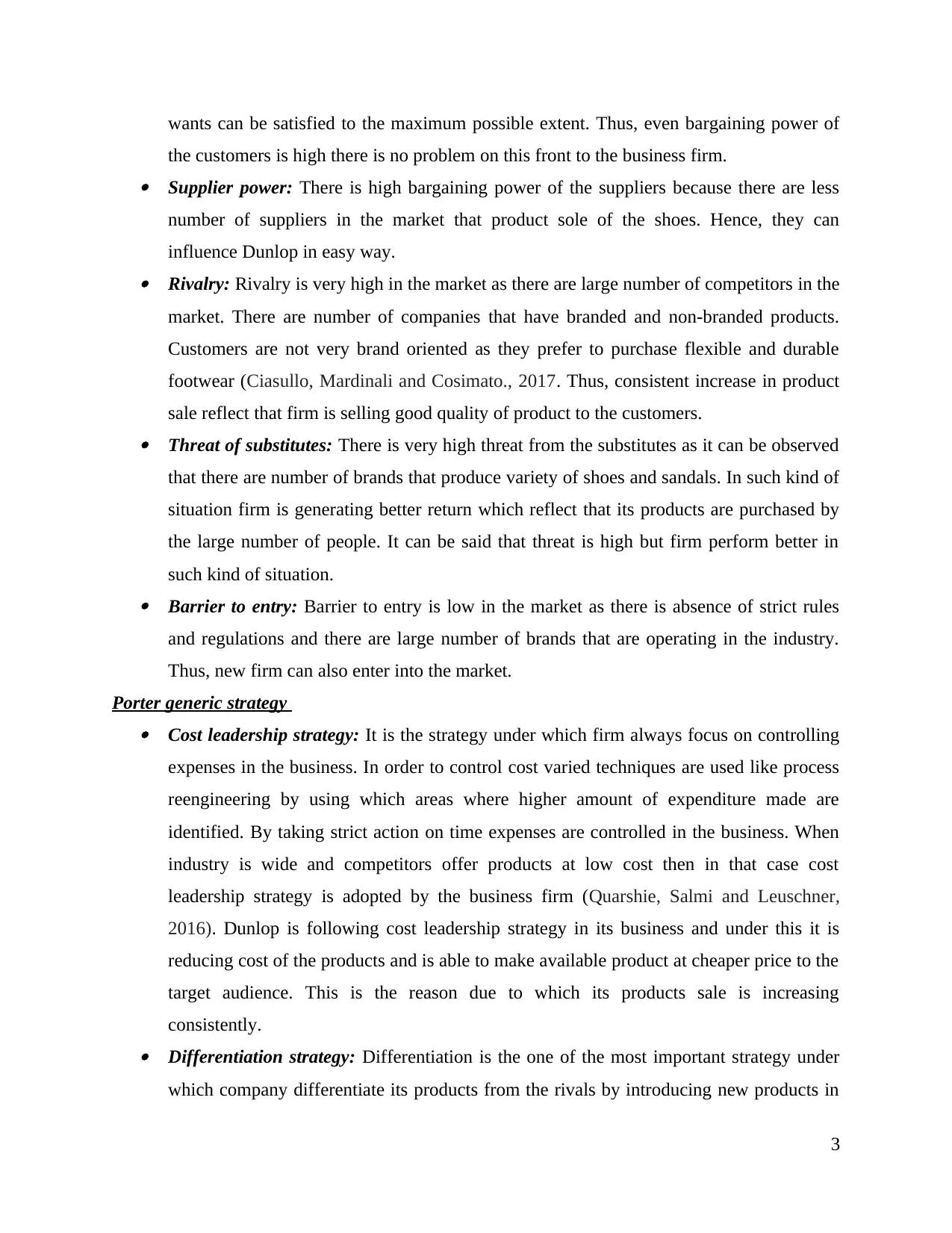
wants can be satisfied to the maximum possible extent. Thus, even bargaining power of
the customers is high there is no problem on this front to the business firm. Supplier power: There is high bargaining power of the suppliers because there are less
number of suppliers in the market that product sole of the shoes. Hence, they can
influence Dunlop in easy way. Rivalry: Rivalry is very high in the market as there are large number of competitors in the
market. There are number of companies that have branded and non-branded products.
Customers are not very brand oriented as they prefer to purchase flexible and durable
footwear (Ciasullo, Mardinali and Cosimato., 2017. Thus, consistent increase in product
sale reflect that firm is selling good quality of product to the customers. Threat of substitutes: There is very high threat from the substitutes as it can be observed
that there are number of brands that produce variety of shoes and sandals. In such kind of
situation firm is generating better return which reflect that its products are purchased by
the large number of people. It can be said that threat is high but firm perform better in
such kind of situation. Barrier to entry: Barrier to entry is low in the market as there is absence of strict rules
and regulations and there are large number of brands that are operating in the industry.
Thus, new firm can also enter into the market.
Porter generic strategy Cost leadership strategy: It is the strategy under which firm always focus on controlling
expenses in the business. In order to control cost varied techniques are used like process
reengineering by using which areas where higher amount of expenditure made are
identified. By taking strict action on time expenses are controlled in the business. When
industry is wide and competitors offer products at low cost then in that case cost
leadership strategy is adopted by the business firm (Quarshie, Salmi and Leuschner,
2016). Dunlop is following cost leadership strategy in its business and under this it is
reducing cost of the products and is able to make available product at cheaper price to the
target audience. This is the reason due to which its products sale is increasing
consistently. Differentiation strategy: Differentiation is the one of the most important strategy under
which company differentiate its products from the rivals by introducing new products in
3
the customers is high there is no problem on this front to the business firm. Supplier power: There is high bargaining power of the suppliers because there are less
number of suppliers in the market that product sole of the shoes. Hence, they can
influence Dunlop in easy way. Rivalry: Rivalry is very high in the market as there are large number of competitors in the
market. There are number of companies that have branded and non-branded products.
Customers are not very brand oriented as they prefer to purchase flexible and durable
footwear (Ciasullo, Mardinali and Cosimato., 2017. Thus, consistent increase in product
sale reflect that firm is selling good quality of product to the customers. Threat of substitutes: There is very high threat from the substitutes as it can be observed
that there are number of brands that produce variety of shoes and sandals. In such kind of
situation firm is generating better return which reflect that its products are purchased by
the large number of people. It can be said that threat is high but firm perform better in
such kind of situation. Barrier to entry: Barrier to entry is low in the market as there is absence of strict rules
and regulations and there are large number of brands that are operating in the industry.
Thus, new firm can also enter into the market.
Porter generic strategy Cost leadership strategy: It is the strategy under which firm always focus on controlling
expenses in the business. In order to control cost varied techniques are used like process
reengineering by using which areas where higher amount of expenditure made are
identified. By taking strict action on time expenses are controlled in the business. When
industry is wide and competitors offer products at low cost then in that case cost
leadership strategy is adopted by the business firm (Quarshie, Salmi and Leuschner,
2016). Dunlop is following cost leadership strategy in its business and under this it is
reducing cost of the products and is able to make available product at cheaper price to the
target audience. This is the reason due to which its products sale is increasing
consistently. Differentiation strategy: Differentiation is the one of the most important strategy under
which company differentiate its products from the rivals by introducing new products in
3
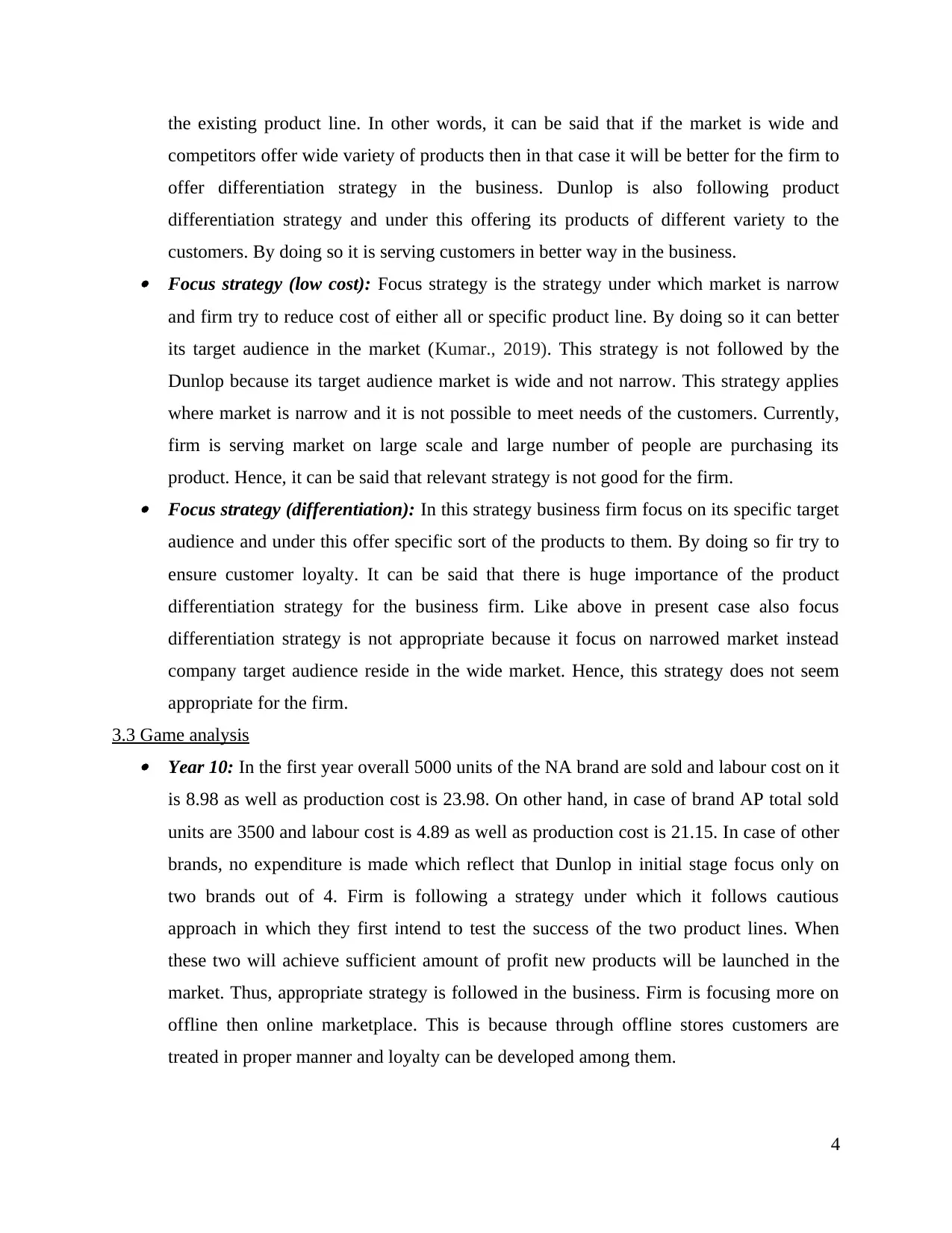
the existing product line. In other words, it can be said that if the market is wide and
competitors offer wide variety of products then in that case it will be better for the firm to
offer differentiation strategy in the business. Dunlop is also following product
differentiation strategy and under this offering its products of different variety to the
customers. By doing so it is serving customers in better way in the business. Focus strategy (low cost): Focus strategy is the strategy under which market is narrow
and firm try to reduce cost of either all or specific product line. By doing so it can better
its target audience in the market (Kumar., 2019). This strategy is not followed by the
Dunlop because its target audience market is wide and not narrow. This strategy applies
where market is narrow and it is not possible to meet needs of the customers. Currently,
firm is serving market on large scale and large number of people are purchasing its
product. Hence, it can be said that relevant strategy is not good for the firm. Focus strategy (differentiation): In this strategy business firm focus on its specific target
audience and under this offer specific sort of the products to them. By doing so fir try to
ensure customer loyalty. It can be said that there is huge importance of the product
differentiation strategy for the business firm. Like above in present case also focus
differentiation strategy is not appropriate because it focus on narrowed market instead
company target audience reside in the wide market. Hence, this strategy does not seem
appropriate for the firm.
3.3 Game analysis Year 10: In the first year overall 5000 units of the NA brand are sold and labour cost on it
is 8.98 as well as production cost is 23.98. On other hand, in case of brand AP total sold
units are 3500 and labour cost is 4.89 as well as production cost is 21.15. In case of other
brands, no expenditure is made which reflect that Dunlop in initial stage focus only on
two brands out of 4. Firm is following a strategy under which it follows cautious
approach in which they first intend to test the success of the two product lines. When
these two will achieve sufficient amount of profit new products will be launched in the
market. Thus, appropriate strategy is followed in the business. Firm is focusing more on
offline then online marketplace. This is because through offline stores customers are
treated in proper manner and loyalty can be developed among them.
4
competitors offer wide variety of products then in that case it will be better for the firm to
offer differentiation strategy in the business. Dunlop is also following product
differentiation strategy and under this offering its products of different variety to the
customers. By doing so it is serving customers in better way in the business. Focus strategy (low cost): Focus strategy is the strategy under which market is narrow
and firm try to reduce cost of either all or specific product line. By doing so it can better
its target audience in the market (Kumar., 2019). This strategy is not followed by the
Dunlop because its target audience market is wide and not narrow. This strategy applies
where market is narrow and it is not possible to meet needs of the customers. Currently,
firm is serving market on large scale and large number of people are purchasing its
product. Hence, it can be said that relevant strategy is not good for the firm. Focus strategy (differentiation): In this strategy business firm focus on its specific target
audience and under this offer specific sort of the products to them. By doing so fir try to
ensure customer loyalty. It can be said that there is huge importance of the product
differentiation strategy for the business firm. Like above in present case also focus
differentiation strategy is not appropriate because it focus on narrowed market instead
company target audience reside in the wide market. Hence, this strategy does not seem
appropriate for the firm.
3.3 Game analysis Year 10: In the first year overall 5000 units of the NA brand are sold and labour cost on it
is 8.98 as well as production cost is 23.98. On other hand, in case of brand AP total sold
units are 3500 and labour cost is 4.89 as well as production cost is 21.15. In case of other
brands, no expenditure is made which reflect that Dunlop in initial stage focus only on
two brands out of 4. Firm is following a strategy under which it follows cautious
approach in which they first intend to test the success of the two product lines. When
these two will achieve sufficient amount of profit new products will be launched in the
market. Thus, appropriate strategy is followed in the business. Firm is focusing more on
offline then online marketplace. This is because through offline stores customers are
treated in proper manner and loyalty can be developed among them.
4
⊘ This is a preview!⊘
Do you want full access?
Subscribe today to unlock all pages.

Trusted by 1+ million students worldwide

Year 11: In year 11 production of the NA brand increase from 5000 to 5127 but at same
time per unit labour cost and production cost also increase from 9.98 to 9.42 and 23.98 to
26.38. Thus, production increase but per unit production also elevate. Across all product
lines except EA sales increase in case of both offline and online marketplace. Thus, it can
be said that overall firm perform better as its market share also increase at fast rate.
Interesting thing is that in case of brand EA and LA no production is done but firm is
purchasing product from other firms and selling through its stores. Year 12: In this year productivity declined in NA brand but reverse is seen in case of AP.
Production is reduced because cost of labour per unit and production cost per unit is
already high. However, production decline cost keeps on increasing which means that
management of the firm is inefficient. However, boost is seen in sales across brands
across multiple sales channels. This reflects that there was previous round unsold stock
due to which even production decline sales increase. Thus, it can be said that in order to
clear old stock firm reduce sale of its products. Huge plunge is observed in online and
offline sales which mean that market conditions are good for the business. Year 13: Across all product lines except EA production increased but by slight amount. It
can be observed that a sale through online and offline platforms is increasing
consistently. On other hand, production is less which means that whatever quantity firm
product is sold less in the market and due to this reason production is reduced. Moreover,
firm intend to control of production in its business with limited resources and due to this
reason also firm is focusing on controlling expenses in the business. Year 14: In the year 14 production cost increase in case of brand NA and LA. However,
labour cost increase in case of NA and AP. Thus, it can be said that NA is the brand
where cost increase at fast rate. Again, in case of NA production slightly increased but
sale through online and offline channel increase and market share also increased which
indicate that there is demand of the product but cost is also high and already there is large
quantity of closing stock in warehouse. Thus, it is mismanagement of resources due to
which cost is high for NA brand. In EA production is not done but sold through online
and offline mode, performance is good as market share is increasing consistently and
margin is also high. Same trend is observed in case of other brands.
5
time per unit labour cost and production cost also increase from 9.98 to 9.42 and 23.98 to
26.38. Thus, production increase but per unit production also elevate. Across all product
lines except EA sales increase in case of both offline and online marketplace. Thus, it can
be said that overall firm perform better as its market share also increase at fast rate.
Interesting thing is that in case of brand EA and LA no production is done but firm is
purchasing product from other firms and selling through its stores. Year 12: In this year productivity declined in NA brand but reverse is seen in case of AP.
Production is reduced because cost of labour per unit and production cost per unit is
already high. However, production decline cost keeps on increasing which means that
management of the firm is inefficient. However, boost is seen in sales across brands
across multiple sales channels. This reflects that there was previous round unsold stock
due to which even production decline sales increase. Thus, it can be said that in order to
clear old stock firm reduce sale of its products. Huge plunge is observed in online and
offline sales which mean that market conditions are good for the business. Year 13: Across all product lines except EA production increased but by slight amount. It
can be observed that a sale through online and offline platforms is increasing
consistently. On other hand, production is less which means that whatever quantity firm
product is sold less in the market and due to this reason production is reduced. Moreover,
firm intend to control of production in its business with limited resources and due to this
reason also firm is focusing on controlling expenses in the business. Year 14: In the year 14 production cost increase in case of brand NA and LA. However,
labour cost increase in case of NA and AP. Thus, it can be said that NA is the brand
where cost increase at fast rate. Again, in case of NA production slightly increased but
sale through online and offline channel increase and market share also increased which
indicate that there is demand of the product but cost is also high and already there is large
quantity of closing stock in warehouse. Thus, it is mismanagement of resources due to
which cost is high for NA brand. In EA production is not done but sold through online
and offline mode, performance is good as market share is increasing consistently and
margin is also high. Same trend is observed in case of other brands.
5
Paraphrase This Document
Need a fresh take? Get an instant paraphrase of this document with our AI Paraphraser
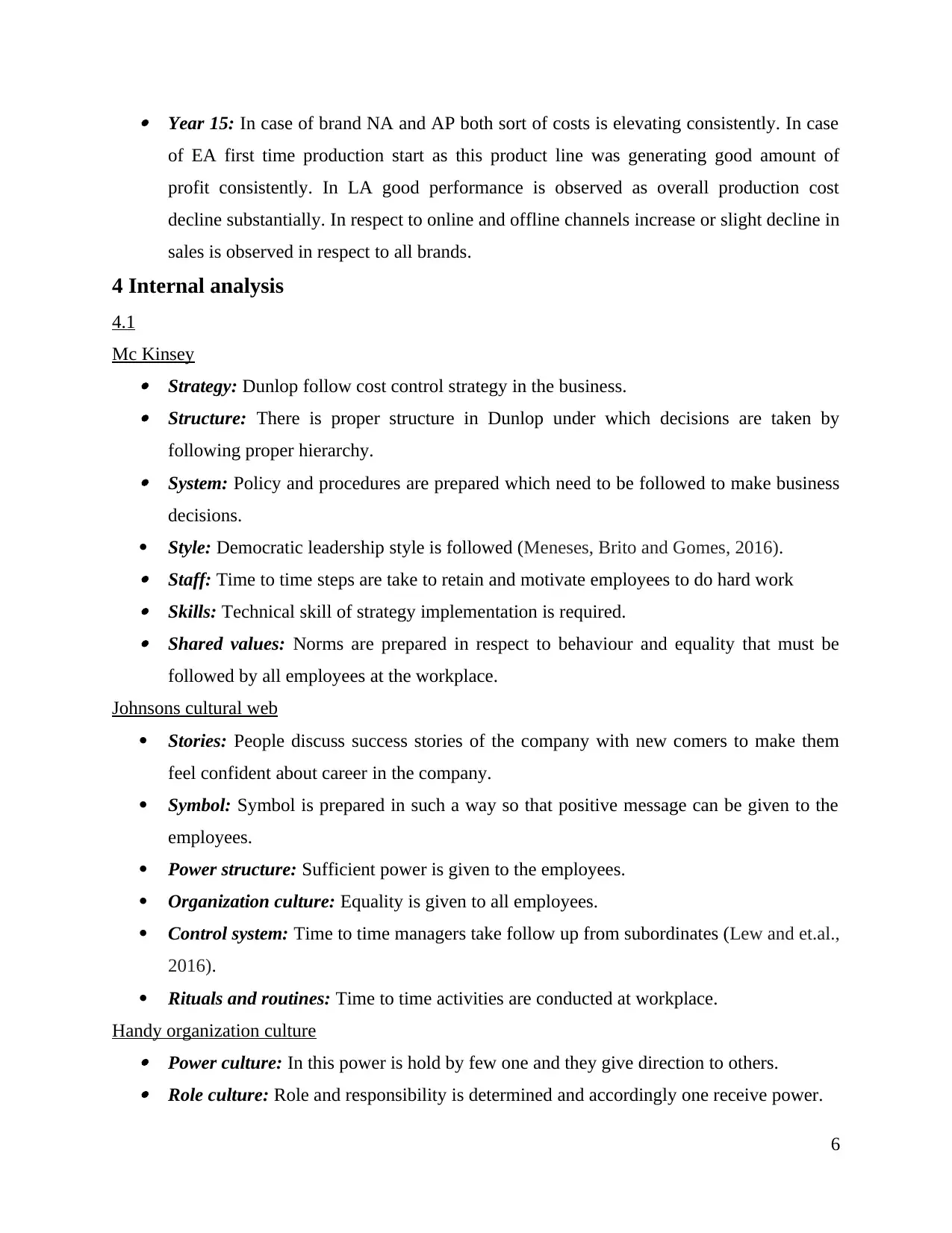
Year 15: In case of brand NA and AP both sort of costs is elevating consistently. In case
of EA first time production start as this product line was generating good amount of
profit consistently. In LA good performance is observed as overall production cost
decline substantially. In respect to online and offline channels increase or slight decline in
sales is observed in respect to all brands.
4 Internal analysis
4.1
Mc Kinsey Strategy: Dunlop follow cost control strategy in the business. Structure: There is proper structure in Dunlop under which decisions are taken by
following proper hierarchy. System: Policy and procedures are prepared which need to be followed to make business
decisions.
Style: Democratic leadership style is followed (Meneses, Brito and Gomes, 2016). Staff: Time to time steps are take to retain and motivate employees to do hard work Skills: Technical skill of strategy implementation is required. Shared values: Norms are prepared in respect to behaviour and equality that must be
followed by all employees at the workplace.
Johnsons cultural web
Stories: People discuss success stories of the company with new comers to make them
feel confident about career in the company.
Symbol: Symbol is prepared in such a way so that positive message can be given to the
employees.
Power structure: Sufficient power is given to the employees.
Organization culture: Equality is given to all employees.
Control system: Time to time managers take follow up from subordinates (Lew and et.al.,
2016).
Rituals and routines: Time to time activities are conducted at workplace.
Handy organization culture Power culture: In this power is hold by few one and they give direction to others. Role culture: Role and responsibility is determined and accordingly one receive power.
6
of EA first time production start as this product line was generating good amount of
profit consistently. In LA good performance is observed as overall production cost
decline substantially. In respect to online and offline channels increase or slight decline in
sales is observed in respect to all brands.
4 Internal analysis
4.1
Mc Kinsey Strategy: Dunlop follow cost control strategy in the business. Structure: There is proper structure in Dunlop under which decisions are taken by
following proper hierarchy. System: Policy and procedures are prepared which need to be followed to make business
decisions.
Style: Democratic leadership style is followed (Meneses, Brito and Gomes, 2016). Staff: Time to time steps are take to retain and motivate employees to do hard work Skills: Technical skill of strategy implementation is required. Shared values: Norms are prepared in respect to behaviour and equality that must be
followed by all employees at the workplace.
Johnsons cultural web
Stories: People discuss success stories of the company with new comers to make them
feel confident about career in the company.
Symbol: Symbol is prepared in such a way so that positive message can be given to the
employees.
Power structure: Sufficient power is given to the employees.
Organization culture: Equality is given to all employees.
Control system: Time to time managers take follow up from subordinates (Lew and et.al.,
2016).
Rituals and routines: Time to time activities are conducted at workplace.
Handy organization culture Power culture: In this power is hold by few one and they give direction to others. Role culture: Role and responsibility is determined and accordingly one receive power.
6
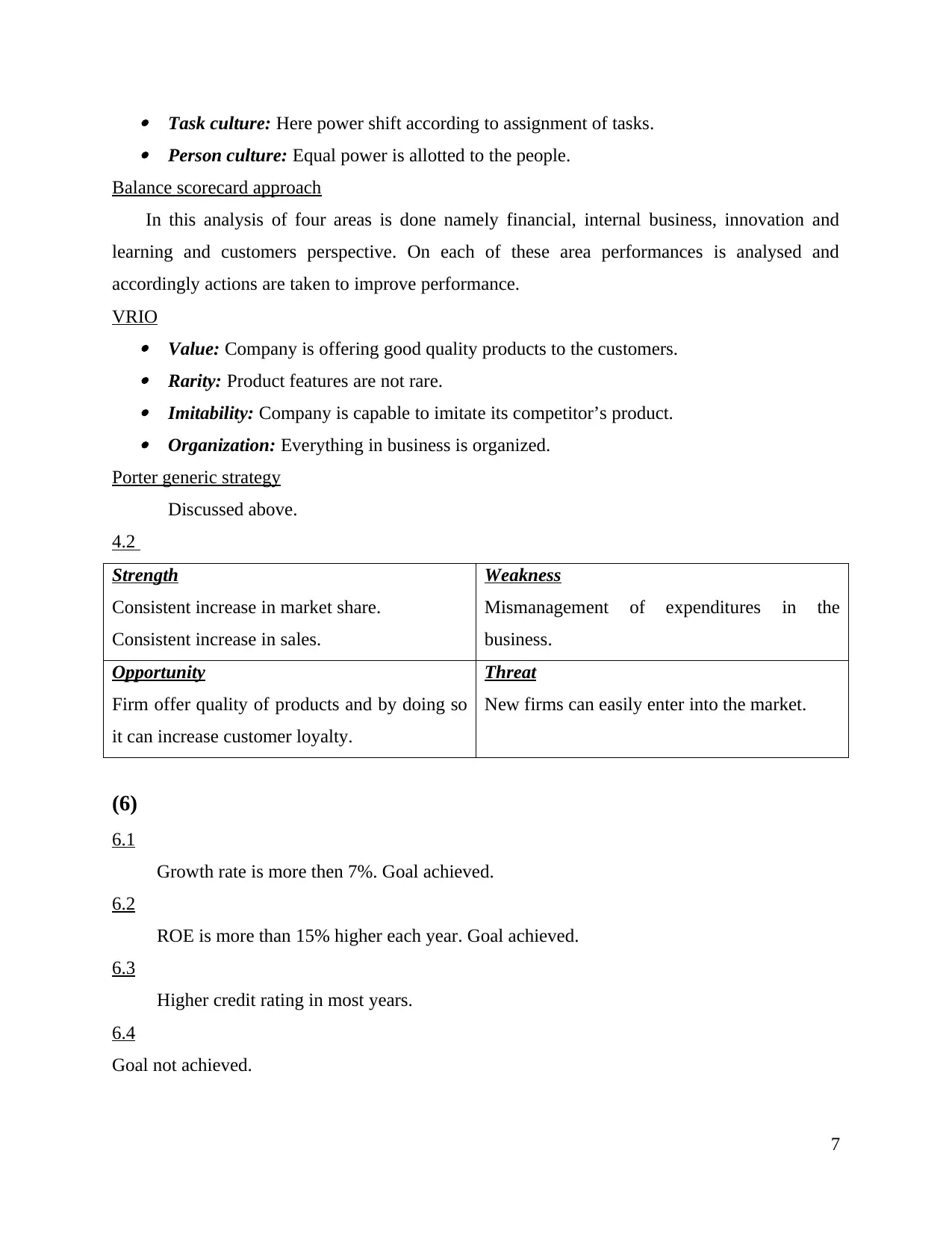
Task culture: Here power shift according to assignment of tasks. Person culture: Equal power is allotted to the people.
Balance scorecard approach
In this analysis of four areas is done namely financial, internal business, innovation and
learning and customers perspective. On each of these area performances is analysed and
accordingly actions are taken to improve performance.
VRIO Value: Company is offering good quality products to the customers. Rarity: Product features are not rare. Imitability: Company is capable to imitate its competitor’s product. Organization: Everything in business is organized.
Porter generic strategy
Discussed above.
4.2
Strength
Consistent increase in market share.
Consistent increase in sales.
Weakness
Mismanagement of expenditures in the
business.
Opportunity
Firm offer quality of products and by doing so
it can increase customer loyalty.
Threat
New firms can easily enter into the market.
(6)
6.1
Growth rate is more then 7%. Goal achieved.
6.2
ROE is more than 15% higher each year. Goal achieved.
6.3
Higher credit rating in most years.
6.4
Goal not achieved.
7
Balance scorecard approach
In this analysis of four areas is done namely financial, internal business, innovation and
learning and customers perspective. On each of these area performances is analysed and
accordingly actions are taken to improve performance.
VRIO Value: Company is offering good quality products to the customers. Rarity: Product features are not rare. Imitability: Company is capable to imitate its competitor’s product. Organization: Everything in business is organized.
Porter generic strategy
Discussed above.
4.2
Strength
Consistent increase in market share.
Consistent increase in sales.
Weakness
Mismanagement of expenditures in the
business.
Opportunity
Firm offer quality of products and by doing so
it can increase customer loyalty.
Threat
New firms can easily enter into the market.
(6)
6.1
Growth rate is more then 7%. Goal achieved.
6.2
ROE is more than 15% higher each year. Goal achieved.
6.3
Higher credit rating in most years.
6.4
Goal not achieved.
7
⊘ This is a preview!⊘
Do you want full access?
Subscribe today to unlock all pages.

Trusted by 1+ million students worldwide
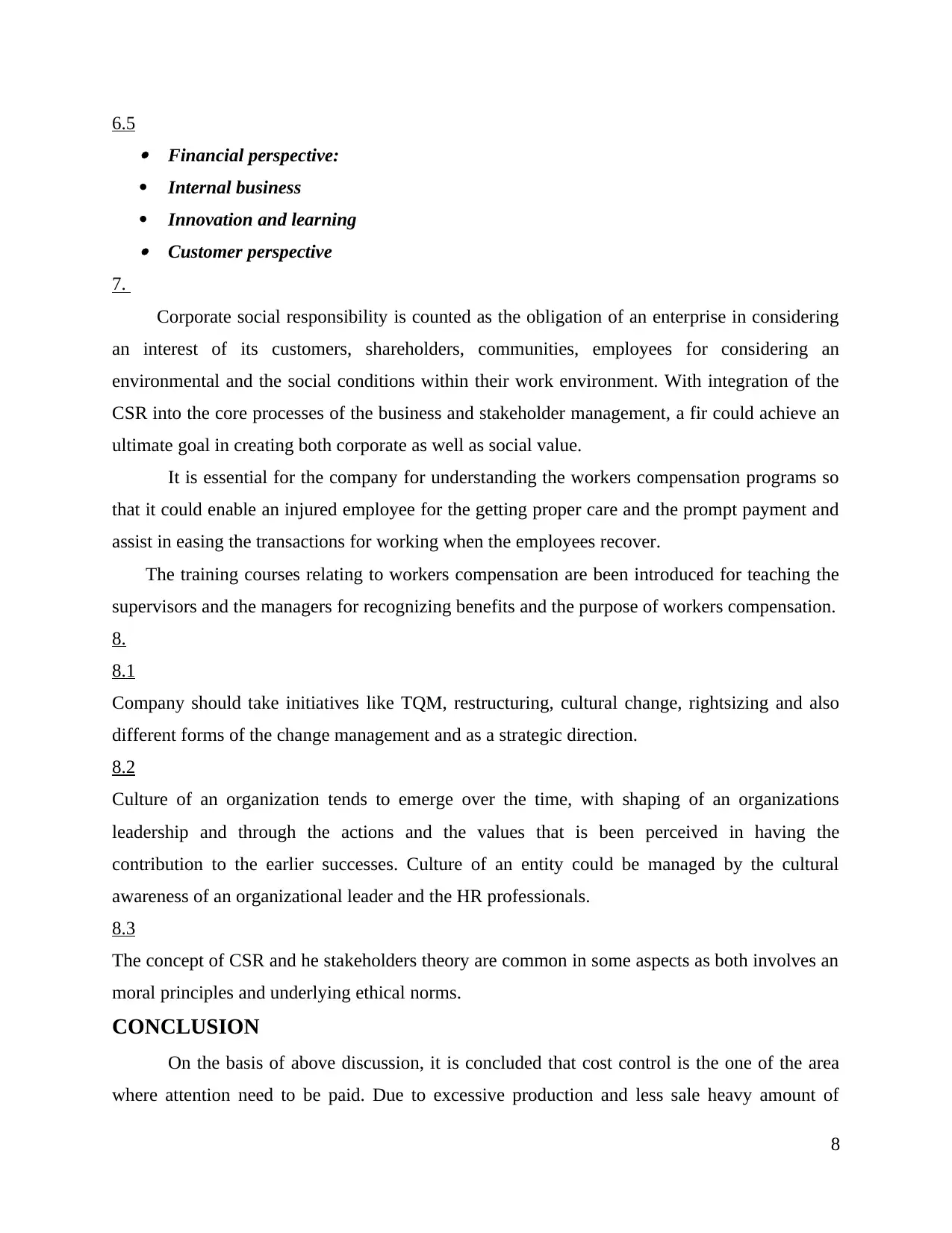
6.5 Financial perspective:
Internal business
Innovation and learning Customer perspective
7.
Corporate social responsibility is counted as the obligation of an enterprise in considering
an interest of its customers, shareholders, communities, employees for considering an
environmental and the social conditions within their work environment. With integration of the
CSR into the core processes of the business and stakeholder management, a fir could achieve an
ultimate goal in creating both corporate as well as social value.
It is essential for the company for understanding the workers compensation programs so
that it could enable an injured employee for the getting proper care and the prompt payment and
assist in easing the transactions for working when the employees recover.
The training courses relating to workers compensation are been introduced for teaching the
supervisors and the managers for recognizing benefits and the purpose of workers compensation.
8.
8.1
Company should take initiatives like TQM, restructuring, cultural change, rightsizing and also
different forms of the change management and as a strategic direction.
8.2
Culture of an organization tends to emerge over the time, with shaping of an organizations
leadership and through the actions and the values that is been perceived in having the
contribution to the earlier successes. Culture of an entity could be managed by the cultural
awareness of an organizational leader and the HR professionals.
8.3
The concept of CSR and he stakeholders theory are common in some aspects as both involves an
moral principles and underlying ethical norms.
CONCLUSION
On the basis of above discussion, it is concluded that cost control is the one of the area
where attention need to be paid. Due to excessive production and less sale heavy amount of
8
Internal business
Innovation and learning Customer perspective
7.
Corporate social responsibility is counted as the obligation of an enterprise in considering
an interest of its customers, shareholders, communities, employees for considering an
environmental and the social conditions within their work environment. With integration of the
CSR into the core processes of the business and stakeholder management, a fir could achieve an
ultimate goal in creating both corporate as well as social value.
It is essential for the company for understanding the workers compensation programs so
that it could enable an injured employee for the getting proper care and the prompt payment and
assist in easing the transactions for working when the employees recover.
The training courses relating to workers compensation are been introduced for teaching the
supervisors and the managers for recognizing benefits and the purpose of workers compensation.
8.
8.1
Company should take initiatives like TQM, restructuring, cultural change, rightsizing and also
different forms of the change management and as a strategic direction.
8.2
Culture of an organization tends to emerge over the time, with shaping of an organizations
leadership and through the actions and the values that is been perceived in having the
contribution to the earlier successes. Culture of an entity could be managed by the cultural
awareness of an organizational leader and the HR professionals.
8.3
The concept of CSR and he stakeholders theory are common in some aspects as both involves an
moral principles and underlying ethical norms.
CONCLUSION
On the basis of above discussion, it is concluded that cost control is the one of the area
where attention need to be paid. Due to excessive production and less sale heavy amount of
8
Paraphrase This Document
Need a fresh take? Get an instant paraphrase of this document with our AI Paraphraser
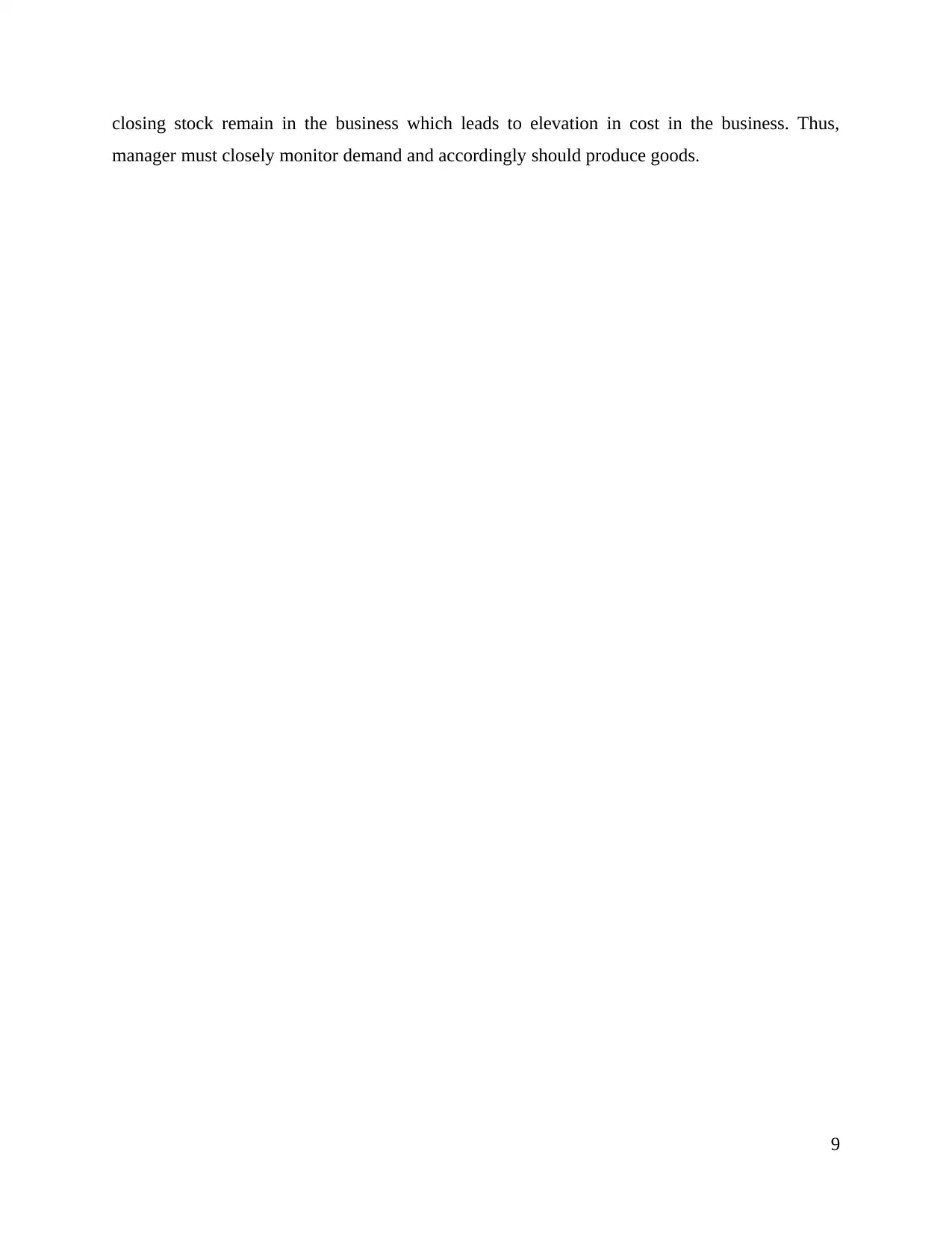
closing stock remain in the business which leads to elevation in cost in the business. Thus,
manager must closely monitor demand and accordingly should produce goods.
9
manager must closely monitor demand and accordingly should produce goods.
9

REFERENCES
Books and Journals
Markkanen, P. and et.al., 2017. Shoes, glues and homework: Dangerous work in the global
footwear industry. Routledge.
Delaney, A., Burchielli, R. and Connor, T., 2015. Positioning women homeworkers in a global
footwear production network: How can homeworkers improve agency, influence and claim
rights?. Journal of Industrial Relations. 57(4). pp.641-659.
Ciasullo, M.V., Cardinali, S. and Cosimato, S., 2017. A strenuous path for sustainable supply
chains in the footwear industry: A business strategy issue. Journal of Global Fashion
Marketing. 8(2). pp.143-162.
Quarshie, A.M., Salmi, A. and Leuschner, R., 2016. Sustainability and corporate social
responsibility in supply chains: The state of research in supply chain management and
business ethics journals. Journal of Purchasing and Supply Management. 22(2). pp.82-97.
Kumar, A., 2019. Oligopolistic suppliers, symbiotic value chains and workers' bargaining power:
labour contestation in South China at an ascendant global footwear firm. Global
Networks. 19(3). pp.394-422.
Meneses, R., Brito, P.Q. and Gomes, P.C., 2016. From offshore-provider to brand creator:
fsQCA of footwear industry. Journal of Business Research. 69(11). pp.5540-5546.
Lew, Y.K. and et.al., 2016. Internationalization process of Chinese SMEs: the role of business
and ethnic-group based social networks. International Journal of Multinational
Corporation Strategy. 1(3/4). pp.247-268.
Siali, F., 2019. RELATIONSHIP BETWEEN BRAND EQUITY AND CONSUMER
PURCHASE DECISION. International Journal of Service Management and
Sustainability. 1(1). pp.58-75.
10
Books and Journals
Markkanen, P. and et.al., 2017. Shoes, glues and homework: Dangerous work in the global
footwear industry. Routledge.
Delaney, A., Burchielli, R. and Connor, T., 2015. Positioning women homeworkers in a global
footwear production network: How can homeworkers improve agency, influence and claim
rights?. Journal of Industrial Relations. 57(4). pp.641-659.
Ciasullo, M.V., Cardinali, S. and Cosimato, S., 2017. A strenuous path for sustainable supply
chains in the footwear industry: A business strategy issue. Journal of Global Fashion
Marketing. 8(2). pp.143-162.
Quarshie, A.M., Salmi, A. and Leuschner, R., 2016. Sustainability and corporate social
responsibility in supply chains: The state of research in supply chain management and
business ethics journals. Journal of Purchasing and Supply Management. 22(2). pp.82-97.
Kumar, A., 2019. Oligopolistic suppliers, symbiotic value chains and workers' bargaining power:
labour contestation in South China at an ascendant global footwear firm. Global
Networks. 19(3). pp.394-422.
Meneses, R., Brito, P.Q. and Gomes, P.C., 2016. From offshore-provider to brand creator:
fsQCA of footwear industry. Journal of Business Research. 69(11). pp.5540-5546.
Lew, Y.K. and et.al., 2016. Internationalization process of Chinese SMEs: the role of business
and ethnic-group based social networks. International Journal of Multinational
Corporation Strategy. 1(3/4). pp.247-268.
Siali, F., 2019. RELATIONSHIP BETWEEN BRAND EQUITY AND CONSUMER
PURCHASE DECISION. International Journal of Service Management and
Sustainability. 1(1). pp.58-75.
10
⊘ This is a preview!⊘
Do you want full access?
Subscribe today to unlock all pages.

Trusted by 1+ million students worldwide
1 out of 12
Related Documents
Your All-in-One AI-Powered Toolkit for Academic Success.
+13062052269
info@desklib.com
Available 24*7 on WhatsApp / Email
![[object Object]](/_next/static/media/star-bottom.7253800d.svg)
Unlock your academic potential
Copyright © 2020–2025 A2Z Services. All Rights Reserved. Developed and managed by ZUCOL.




